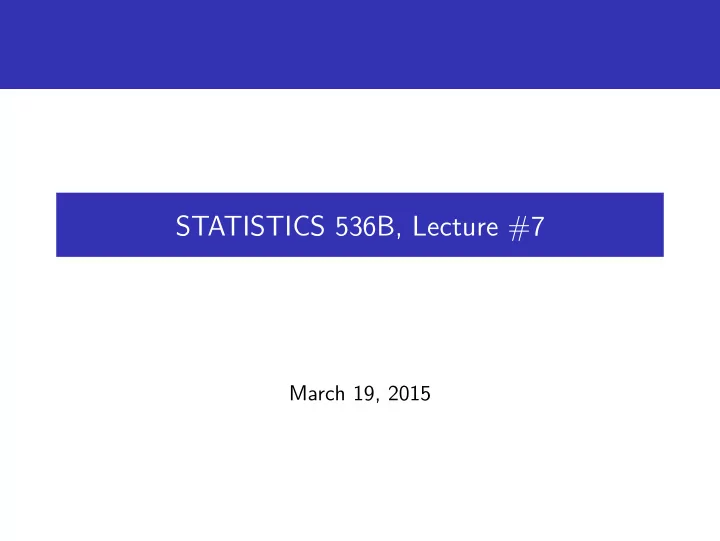

STATISTICS 536B, Lecture #7 March 19, 2015
Network Meta-Analysis? Indirect Comparisons? Treatment Success trial # Drug A Drug B Drug C 1 10/200 15/100 2 20/200 20/100 3 30/200 25/100 4 10/100 55/200 5 20/100 60/200 6 30/100 70/200 How much better is Drug C than Drug A?
As before represent i -th trial data via sample log-OR and SE: ( y i , σ i ) (But keep track of which pair of treatments are being compared in each trial.)
Random effect structure - in i-th trial Generically, think of δ i , RS as being the log-odds-ratio for treatment S compared to treatment R, in the i-th study population. In fact, with three treatments (A,B,C) we assume the following random effects structure � δ i , AB �� d AB � � � �� 1 0 . 5 , τ 2 δ i = ∼ N δ i , AC d AC 0 . 5 1 with the implicit consistency assumption that δ i , BC = δ i , AC − δ i , AB , and similarly d BC = d AC − d AB . Why correlation 0.5??? So can think about ( Y i , RS | δ i ) ∼ N ( δ i , RS , σ 2 i )
So marginally (with random effects integrated away...) ∼ N ( Xd , D ) , Y
And we know how to handle linear models ∼ N ( Xd , D ) , Y leads to ˆ ( X T D − 1 X ) − 1 X T D − 1 Y = d and Var( ˆ ( X T D − 1 X ) − 1 d ) =
Back to our toy example > y [1] 1.21 0.81 0.64 1.23 0.54 0.23 > sqrt(sig2) [1] 0.43 0.34 0.30 0.37 0.29 0.26 > dsgn [,1] [,2] [1,] 1 0 [2,] 1 0 [3,] 1 0 [4,] -1 1 [5,] -1 1 [6,] -1 1 > tau2 <- .15^2
vr <- solve(t(dsgn) %*% solve(diag(sig2+tau2)) %*% dsgn) est <- vr%*%t(dsgn)%*%solve(diag(sig2+tau2))%*%y ### drug B versus drug A > c(est[1],sqrt(vr[1,1])) [1] 0.83 0.22 ### drug C versus drug A > c(est[2], sqrt(vr[2,2])) [1] 1.41 0.29 ### drug C versus drug B > cntrst <- c(-1,1) > c( sum(cntrst*est), sqrt(t(cntrst)%*%vr%*%cntrst)) ) [1] 0.58 0.19
How would our toy example actually be analyzed? Success counts for (A,B) trial: Z i , A ∼ Binomial( n i , expit( µ i )) Z i , B ∼ Binomial( n i , expit( µ i + δ i , AB )) Or for (B,C) trial: Z i , B ∼ Binomial( n i , expit( µ i + δ i , AB )) Z i , C ∼ Binomial( n i , expit( µ i + δ i , AC )) Then µ i ∼ N (0 , κ 2 ) and, as before, � δ i , AB �� d AB � � � 1 0 . 5 �� , τ 2 δ i = ∼ N δ i , AC 0 . 5 1 d AC
In fact, typically interpreted/fit as a Bayesian hierarchical model, say using WinBUGS network meta-analysis all other biostat. apps. Bayesian rule exception non-Bayesian exception rule
Recommend
More recommend